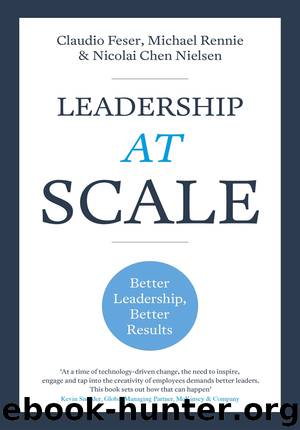Leadership at Scale by Claudio Feser

Author:Claudio Feser
Language: eng
Format: epub
Publisher: Quercus
Published: 2018-10-14T16:00:00+00:00
FIGURE 7.5 Performance grid for the leadership model theme ‘putting the customer first’
In addition to the performance grids, we also ensure that roles and responsibilities are clear down the line, modifying the organization structure, processes and systems as needed. This also includes modifying key performance indicators as required, starting with the employees who are part of the programme.
Sign off the business case
The final part of this stage is to develop and sign off the business case. Far from being a matter of process, the business case is a critical way to set the leadership development intervention up for short-term and long-run success. The business case should at a minimum include four main elements: target impact, work plan, budget and organizational requirements to deliver the programme.
First is the target impact. The impact in terms of the critical behaviour shifts and leaders reached should already have been discussed during the first stage. However, the business case crystallizes the aspiration – it covers a comprehensive set of measures and ensures they are measurable, time-bound and linked to organizational performance. We discussed in Chapter 6 four types of measurement (participant reaction, learning, behavioural changes and organizational results). In the business case, we typically focus on quantifying behavioural changes (for example, improvements in a 360-degree assessment) and organizational results (for example, increase in leadership outcome in the OHI, increasing in ancillary outcomes in the OHI, business impact from the breakthrough projects, such as increased customer satisfaction, increased revenues from new products, and cost savings).
The second key element of the business case is the work plan, including key milestones. In the diagnose and design/development phases, key elements are to conduct interviews and focus groups (and potentially an OHI), conduct top team workshops, design and launch a 360-degree feedback survey for programme participants (built around the leadership model and competency grids), designing the programme content and embedment mechanisms, and selecting programme participants. Key elements during delivery are inauguration of the overall programme (depending on scale), start of each cohort type (signifying that the content is ready), start and finish of each subsequent cohort, governance council meetings, and key communication items. Key milestones during the Develop stage are usually not specified in detail at this moment, save for a date for programme evaluation and assessment, and a decision for the next steps.
The third key element of the business case is the budget. The constituents of the budget are the number of participants per cohort, the depth of each journey (for example, the number of forum days and coaching days per cohort), facilitator and coaching costs (whether internal or external), technology costs (software and hardware), venue costs (if offsite), travel, F&B and accommodation for participants and faculty, material and content costs and programme office costs. Organizations should build a dynamic model, with flexible fields for the different programme elements. The programme budget drives what is ultimately included in the programme design and how the programme is run, and should be clarified early. It is important for organizations to consider
Download
This site does not store any files on its server. We only index and link to content provided by other sites. Please contact the content providers to delete copyright contents if any and email us, we'll remove relevant links or contents immediately.
Hit Refresh by Satya Nadella(8993)
The Compound Effect by Darren Hardy(8733)
Change Your Questions, Change Your Life by Marilee Adams(7564)
Nudge - Improving Decisions about Health, Wealth, and Happiness by Thaler Sunstein(7459)
The Black Swan by Nassim Nicholas Taleb(6946)
Deep Work by Cal Newport(6817)
Daring Greatly by Brene Brown(6367)
Rich Dad Poor Dad by Robert T. Kiyosaki(6316)
Principles: Life and Work by Ray Dalio(6130)
Man-made Catastrophes and Risk Information Concealment by Dmitry Chernov & Didier Sornette(5877)
Playing to Win_ How Strategy Really Works by A.G. Lafley & Roger L. Martin(5773)
Digital Minimalism by Cal Newport;(5586)
Big Magic: Creative Living Beyond Fear by Elizabeth Gilbert(5555)
The Myth of the Strong Leader by Archie Brown(5374)
The Slight Edge by Jeff Olson(5315)
Discipline Equals Freedom by Jocko Willink(5241)
The Motivation Myth by Jeff Haden(5123)
Stone's Rules by Roger Stone(4989)
The Laws of Human Nature by Robert Greene(4925)
